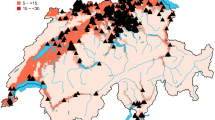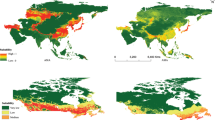Abstract
Modeling of the gypsy moth and nun moth ranges using climatic predictors and the updated climate database suggested potential consequences of the observed climate changes for these economically important insects. The climate changes during 1981–2010, as compared to those during 1951–1980, have predetermined a considerable northward and eastward expansion of these moths. New areas climatically suitable for the gypsy moth but isolated from its main range have appeared in Eastern Siberia, in the Aldan Upland region and to the north of Lake Baikal up to 60°N. The greatest expansion of the nun moth range was observed in the Lena Plateau and northern Aldan Upland regions. Some insignificant reduction of its range was found only in Altai. Merging of the Euro-Siberian and Far Eastern parts of the nun moth range is also possible.
Similar content being viewed by others
References
Assessment Report on Climate Changes and Their Consequences in the Territory of the Russian Federation, Vol. 1: Climate Changes (Roshydromet, Moscow, 2008) [in Russian].
Belov, D.A., “A Gypsy Moth Outbreak in Moscow,” in Ecology, Monitoring, and Rational Nature Management: Research Papers, Issue 294 (1) (Moscow Inst. of Forestry, Moscow, 1998), pp. 181–190 [in Russian].
Biological Invasions in Aquatic and Terrestrial Ecosystems, Ed. by A.F. Alimov and N.G. Bogutskaya (KMK, Moscow, 2004) [in Russian].
Climate Change: The Physical Science Basis. Contribution of Working Group I to the Fourth Assessment Report of the Intergovernmental Panel on Climate Change (Cambridge Univ., Cambridge, 2007a).
Climate Change: Impacts, Adaptation and Vulnerability. Contribution of Working Group II to the Fourth Assessment Report of the Intergovernmental Panel on Climate Change (Cambridge Univ., Cambridge, 2007b).
Climate Change: Mitigation. Contribution of Working Group III to the Fourth Assessment Report of the Intergovernmental Panel on Climate Change (Cambridge Univ., Cambridge, 2007c).
Gninenko, Yu.I., “Some Ecological Changes in the Siberian Forests: Outbreaks of New Species,” in Problems of Regional Ecology: Proc. of All-Russian Conference (Krasnoyarsk, 2000), pp. 174–175.
Gninenko, Yu.I., “Invasions of Alien Species into Forest Communities,” in Ecological Security and Invasions of Alien Organisms: Materials of All-Russian Conference on Ecological Security in Russia, Moscow, 4-5 June 2002 (Moscow, 2002), pp. 65–74.
Gninenko, Yu.I., Shchurov, V.I., Lyanguzov, M.I., and Gninenko, A.Yu., “Specific Biological Traits of the Nun Moth in the Russian Forests,” Lesovedenie, No. 5, 65–68 (2005).
Ilyinykh, A.V. and Krivets, S.A., “Results of Pheromone Analysis of the Gypsy Moth Lymantria dispar (L.) (Lepidoptera, Lymantriidae) Monitoring in the Southeast of Western Siberia,” in Proceedings of Saint Petersburg Academy of Forestry, Issue 196 (St. Petersburg, 2011), pp. 45–53 [in Russian].
Kozhanchikov, I.V., Fauna of the USSR. Insecta, Lepidoptera, Vol. 12: Tussock Moths (Orgyidae) (USSR Acad. Sci., Moscow, 1950) [in Russian].
Markov, V.A., “Development of the Nun Moth Lymantria monacha L. (Lepidoptera, Lymantriidae) during the Period of Its Population Growth,” Entomol. Obozr. 74 (74), 323–341 (1995).
Orozumbekov, A.A., Liebhold, A.M., Ponomarev, V.I., and Tobin, P.C., “Gypsy Moth (Lepidoptera: Lymantriidae) in Central Asia,” Amer. Entomol. 55 (55), 258–264 (2009).
Ponomarev, V.I., Specific Traits in the Ecology and Population Genetics of the Gypsy Moth (Russian Acad. Sci., Yekaterinburg, 1992) [in Russian].
Ponomarev, V.I., Orozumbekov, A.A., Mamytov, A.M., and Kozhoev, Sh.S., “The Decline of a Permanent Gypsy Moth Outbreak in Nut Tree Forests,” Lesnoe Khozyaistvo, No. 6, 45–46 (2005).
Semenov, S.M., Yasyukevich, V.V., and Gelver, E.S., Detection of Climatogenic Changes (Meteorologiya i Gidrologiya, Moscow, 2006) [in Russian].
Sokolov, G.I., “Forest Pests Outbreaks in Chelyabinsk Province,” in Proceedings of Saint Petersburg Academy of Forestry, Issue 187 (St. Petersburg, 2009), pp. 331–342 [in Russian].
Survey of the Sanitary and Phytopathological State of the Russian Forests for 2009 (Russian Center of Forest Protection, Pushchino, 2010) [in Russian].
Vanhanen, H., Veteli, T.O., Päivinen, S., et al., “Climate Change and Range Shifts in Two Insect Defoliators: Gypsy Moth and Nun Moth–a Model Study,” Silva Fennica 41 (41), 621–638 (2007).
Vasiliev, V.P. and Livshits, I.Z., Orchard Pests (Kolos, Moscow, 1984) [in Russian].
Zamotailov, A.S. and Shchurov, V.I., “Insect Fauna of the Northwestern Caucasus at the Modern Stage of Global Climate Development: Perils and Prospects,” Trudy Kuban. Gos. Agrar. Univ., No. 1 (1), 32–39 (2010).
Author information
Authors and Affiliations
Corresponding author
Additional information
Original Russian Text © V.V. Yasyukevich, C.N. Titkina, E.A. Davidovich, N.V. Yasyukevich, 2013, published in Zoologicheskii Zhurnal, 2013, Vol. 92, No. 11, pp. 1377–1382.
Rights and permissions
About this article
Cite this article
Yasyukevich, V.V., Titkina, C.N., Davidovich, E.A. et al. Changes in range boundaries of the gypsy moth and the nun moth (Lymantria dispar, L. monacha, Lymantriidae, Lepidoptera) due to the global warming: a model approach. Entmol. Rev. 95, 1144–1148 (2015). https://doi.org/10.1134/S0013873815080229
Received:
Published:
Issue Date:
DOI: https://doi.org/10.1134/S0013873815080229




